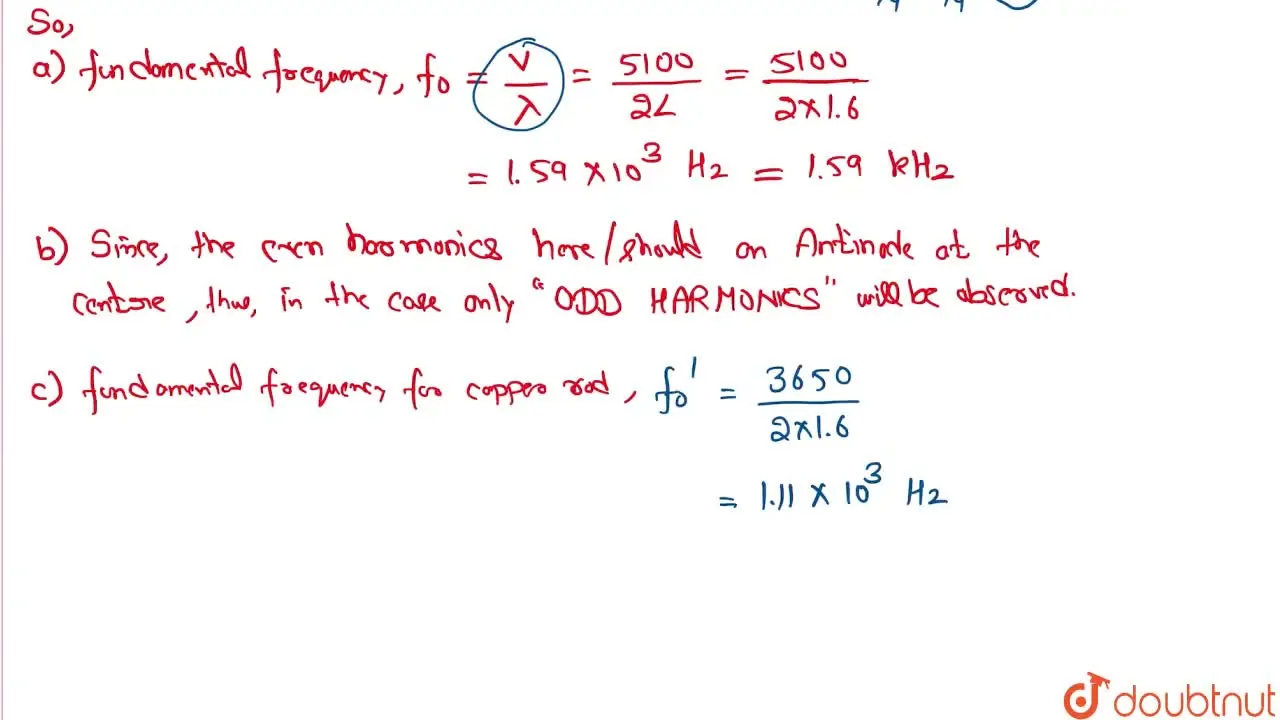An aluminimum rod 1.60m long is held at its centre. It is stroked with a rosin - coated cloth to set up a longitudinal vibration. The speed of sound in thin rod of aluminium is 5100m/s. (a) What is the fundamental frequency of the waves established in the rod ? (b) What harmonics are set up in the rod held in this manner ? (c ) What would be the fundamental frequency if the rod were copper , in which the speed of sound is 3650m/s?
Standing waves are important because any wave confined to a restricted region of space will be reflected bak onto itself by the boundaries of the region . Then the travelling waves moving in opposite directions constitute a standing wave . The rod can sing a few hundred hertz and at integer - multiple higher harmonics . The frequency will be proportionately lower with copper .
We must identify where nodes and antinodes are used use the fact that antinodes are separated by half a wavelength with v=fλ.
a. Since the central clamp established a node at the centre, the fundamental node of vibration will be ANA. Thus , the rod length is L=d∀=λ/2.
Our first harmonic frequency is
f1=vλ1=v2L=5100m/s3.20m=1.59Hz
b. Since the rod is free at each end , the ends will be antinodes . The next vibration state will not have just one more node and one more antinode , reading ANANA, as shown in the diagram , with a wavelength and frequency of
λ=2L3andf=vλ=3v2L=3f1
Since f2=2f1 was bypasses as having an antinode at the centre rather than the node required , we know that we get only odd harmonics .
f=nv2L=n(1.59KHz)
for n=1,3,5,....
c. For a copper rod , the density is higher , so the speed of sound is lower , and the fundamental frequency is lower .
f1=v2L=3560m/s3.20m=1.11kHz
The second is not at just a few hertz , but is a sqeak or a squeal at over a thousand hertz . Only a few higher harmonics are in the audible range . Sound really moves fast in materials that are stiff against compression . For a thin rod , it is young's modulus that determines the speed of a longittudinal wave .

Similar Questions
If the speed of a transverse wave on a stretched string of length 1 m is 60ms−1, what is the fundamental frequency of vibration ?
View SolutionThe longitudinal wave velocity in solids in the form of a rod
View SolutionWhat will be the speed of sound in a perfectly rigid rod?
View SolutionA granite rod of 60 cm length is clamped at its middle point and is set into longitudinal vibrations. The density of granite is 2.7×103kg/m3 and its Young’s modulus is 9.27×1010 Pa. What will be the fundamental frequency of the longitudinal vibrations ?
View SolutionA steel rod 100 cm long is clamped at its middle. The fundamental frequency of longitudinal vibrations of the rod is given to be 2.53k Hz. What is the speed of sound in steel?
View SolutionA steel rod 100 cm long is clamped at its centre. The fundmental frequency of longitudinal viberations of the rod are given to be 2.53kHz. What is the speed of sound is steel?
View SolutionA metal rod of length L is clamped at a distance L/4 from one end. It is set into longitudinal vibrations . The wavlength for fundamental mode of vibrations will be
View SolutionA metal rod 40cm long is dropped on to a wooden floor and rebounds into air . Compressional waves of many frequencies are thereby set up in the rod . If the speed of compressional waves in the rod in 5500m/s, what is the lowest frequency of compressional waves to which the rod resonates as it rebounds?
View SolutionA 1.50 m long rope is stretched between two supports with a tension that makes the speed of transverse waves 48.0m/s. What are the wavelength and frequency of
(a) the fundamental?
(b) the second overtone?
(c) the fourth harmonic?View SolutionA steel rod 100 cm long is clamped at its middle. The fundamental frequency of loungitudinal vibrations of the fundamental frequency of longitudinal vibrations of the rod are given to be 2.53 KHz. What is the speed of soind in steel?
View Solution


